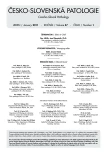Pseudoglandulárny (adenoidný, akantolytický) dlaždicovobunkový karcinóm penisu. Popis prípadu
:
M. Zámečník 1; P. Mukenšnabl 2; A. Chlumská 2,3
:
Medicyt, s. r. o., laboratory Trenčín, Slovak Republic
1; Šikl's Department of Pathology, Faculty Hospital, Charles University, Plzeň, Czech Republic
2; Laboratory of Surgical Pathology, Plzeň, Czech Republic
3
:
Čes.-slov. Patol., 47, 2011, No. 1, p. 15-18
:
Original Article
Prezentovaný je prípad pseudoglandulárneho (adenoidného, akantolytického) dlaždicovobunkového karcinómu penisu u 60-ročného pacienta. Tumor obsahoval okrem štruktúr konvenčného dlaždicovobunkového karcinómu komponent pseudoglandulárny, ktorý napodobňoval tubuly adenokarcinómu. V epidermis vedľa tumoru nebola nájdená prekurzorová dysplastická lézia. Imunohistochemicky exprimovali bunky nádoru pancytokeratín AE1/AE3, p53 a p63, a boli negatívne na endotelové markery, CEA a p16. Farbenia na mucín boli negatívne. Metastázy boli prítomné v regionálnych lymfatických uzlinách a vo funiculus spermaticus. Štyri týždne po operácii sa objavili početné kožné/podkožné metastázy v podbrušku, v oboch ingvinách a na prednej mediálnej strane stehien. Vyšetrenie CT zistilo pakety metastaticky postihnutých lymfatických uzlín v panve. Vysoké štádium pri prezentácii tumoru a ďalší priebeh potvrdzujú, že pseudoglandulárny dlaždicovobunkový karcinóm penisu je vysoko agresívny tumor.
Key words:
adenosquamous carcinoma - pseudoglandular (adenoid, acantholytic) squamous cell carcinoma - penis - p16 - p53
Sources
1. Banerjee SS, Eyden BP, Wells S, et al. Pseudoangiosarcomatous carcinoma: a clinicopathological study of 7 cases. Histopathology 1992; 21: 13–23.
2. Conde-Taboada A, Florez A, De la Torre C, et al. Pseudoangiosarcomatous squamous cell carcinoma of the skin arising adjacent to decubitus ulcers. Am J Dermatopathol 2005; 27: 142–144.
3. Nappi O, Wick MR, Pettinato G, et al. Pseudovascular adenoid squamous cell carcinoma of the skin. A neoplasm that may be mistaken for angiosarcoma. Am J Surg Pathol 1992;16: 429–438.
4. Zidar N, Gale N, Zupevc A, et al. Pseudovascular adenoid squamous-cell carcinoma of the oral cavity - a report of two cases. J Clin Pathol 2006; 59: 1206-1208.
5. Eusebi V, Lamovec J, Cattani MG, et al. Acantholytic variant of squamous cell carcinoma of the breast. Am J Surg Pathol 1986; 10: 855–861.
6. Nappi O, Swanson PE, Wick MR. Pseudovascular adenoid squamous cell carcinoma of the lung: clinicopathologic study of three cases and comparison with true pleuropulmonary angiosarcoma. Hum Pathol 1994; 25: 373–378.
7. Pitt MA, Morphopoulos G, Bisset DL. Pseudoangiosarcomatous carcinoma of the genitourinary tract. J Clin Pathol 1995; 48: 1059–1061.
8. Horie Y, Kato M. Pseudovascular squamous cell carcinoma of the uterine cervix: a lesion that may simulate an angiosarcoma. Pathol Int 1999; 49: 170–174.
9. Cunha IW, Guimaraes GC, Soares F, et al. Pseudoglandular (adenoid, acantholytic) penile squamous cell carcinoma: a clinicopathologic and outcome study of 7 patients. Am J Surg Pathol 2009; 33: 551-555.
10. Colecchia M, Insabato L. Pseudoglandular (adenoid, acantholytic) penile squamous cell carcinoma. Am J Surg Pathol 2009; 33: 1421-1422.
11. Cubilla AL, Dillner E, Schelhammer PF. Tumours of the penis. Malignant epithelial tumours. In: Eble J et al. (eds). World Health Organization Classification of Tumours. Pathology and Genetics of Tumours of the Urinary System and Male Genital Organs. Lyon: IARCPress; 2004: 281-290.
12. Velazquez EF, Ayala GE, Liu H, et al. Histologic grade and perineural invasion are more important than tumor thickness as predictor of nodal metastasis in penile squamous cell carcinoma invading 5 to 10mm. Am J Surg Pathol 2008; 32: 974–979.
13. Cubilla AL, Meijer JLM, Young RH. Morphological features of epithelial abnormalities and precancerous lesions of the penis. Scand J Urol Nephrol Suppl 2000; 34: 215–219.
14. Cubilla AL, Velazquez EF, Young RH. Epithelial lesions associated with invasive penile squamous cell carcinoma: a pathologic study of 288 cases. Int J Surg Pathol 2004; 12: 351–364.
15. Benevolo M, Mottolese M, Marandino F, et al. Immunohistochemical expression of p16 (INK4a) is predictive of HR-HPV infection in cervical low-grade lesions. Mod Pathol 2006; 19: 384-391.
16. Qi XP, Lin GB, Zhu YL, et al. Pseudoangiosarcomatous squamous cell carcinoma of the penis: a case report with clinicopathological and human papilloma virus analyses. Zhonghua Nan Ke Xue 2009; 15: 134-139.
17. Horn LC, Liebert UG, Edelmann J, et al. Adenoid squamous carcinoma (pseudoangiosarcomatous carcinoma) of the vulva: a rare but highly aggressive variant of squamous cell carcinoma-report of a case and review of the literature. Int J Gynecol Pathol 2008; 27: 288-291.
Labels
Anatomical pathology Forensic medical examiner ToxicologyArticle was published in
Czecho-Slovak Pathology

2011 Issue 1
Most read in this issue
- The New System for Reporting Fine Needle Aspiration Biopsies of the Thyroid Gland: Bethesda 2010
- Pseudoglandular (adenoid, acantholytic) squamous cell carcinoma of the penis. A case report
- Burkitt lymphoma with unusual granulomatous reaction. A case report
